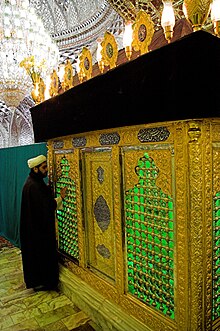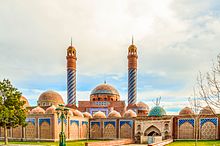Imamzadeh
Animamzadeh(Persian:امامزاده,romanized:emāmzādeh) is aPersianterm with two related meanings: a type of holy person in Shia Islam, and the shrine-tomb of such a person.
Firstly, it means an immediate descendant of aShi'iImam.The term is also used inUrduandAzeri.Imamzadeh means "offspring" or descendant of an imam. There are many different ways of spelling the word in English,[1]such as imamzada, imamzadah and emamzadah.[2][3]Imamzadeh are basically theSyed'sor Syeda's as they have descended from the Imams.[citation needed]Imamzadehs are also sayyids, though not all sayyids are considered imamzadehs.[3]
There are many important imamzadehs. Two of these areFātimah bint Mūsā,the sister of ImamAli al-Ridha,the eighthTwelverImam, andZaynab bint Ali,daughter ofAli,considered by Shi'i Muslims to be the first Imam and by Sunni Muslims as the fourthRashid.Imamzadehs are not traditionally women.[3]
Secondly, imamzadeh is a term for a shrine-tomb of the descendants of Imams, who are directly related toMuhammad.[1]These shrines are only for the descendants of Imams and they are not for the Imams themselves.[3]These shrine-tombs are used as centers of Shi'i devotion and pilgrimages. They are believed to have miraculous properties and the ability to heal.[4]Many of them are located in Iraq, Medina, India and Iran.



Many people visit the imamzadehs that are relatively close to them. There are also special ziyarat-namas (pilgrimages) for many of the imamzadehs. Some of these pilgrimages even happen annually during the certain time of year.[3]Some of the imamzadehs are not as well kept as others. According to Reinisch, an imamzadeh that he saw was mostly in ruins, though it is still important.[5]
List of Imamzadeh shrine-tombs[edit]
- Imamzadeh Hamzah, Tabriz
- Imamzadeh Hamzeh, Kashmar
- Imamzadeh Ja'far, Borujerd
- Imamzadeh Ja'far, Damghan
- Imamzadeh Ja'far, Isfahan
- Imamzadeh Saleh, Shemiran
- Imamzadeh Sultan Mutahhar
- Imamzadeh (Ganja)
- Imamzadeh Ahmad
- Imamzadeh Esmaeil and Isaiah mausoleum
- Imamzadeh Haroun-e-Velayat
- Imamzadeh Mohammad
- Imamzadeh Seyed Morteza
- Imamzadeh Shah Zeyd
- Imamzade Hossein, Qazvin
- Shah-Abdol-Azim shrine
- Shah Cheragh
- Tomb of Ali ibn Hamzah, Shiraz[6][7]
- Tomb of Seyed Alaeddin Husayn
Popular culture[edit]
The Imamzadehs were so influential that some cities or parts of cities are named after the Imamzadehs who are buried there, for example,Torbat-e Heydarieh,Astaneh-ye Ashrafiyehin Gilan, Astaneh near Arak, andShahreza.[8]
See also[edit]
References[edit]
- ^abEsposito, John L. 2003. The Oxford Dictionary of Islam. Oxford University Press. Oxford. p 136.
- ^Glasse, Cyril. 2001. The Concise Encyclopedia of Islam. Revised Edition. Stacey International, London. p. 213
- ^abcdeLambton, A.K.S. "Imamzada." Encyclopedia of Islam, Second Edition. Edited by: P. Bearman, Th. Bianquis, C.E. Bosworth, E. Van Donzel and W.P. Heinrichs. Brill, 2010. Brill Online. Augustana. 6 April 2010 <http:// brillonline.nl/subscriber/entry?entry=islam_SIM-3552[permanent dead link]>
- ^Esposito, John L. 1995. The Oxford Encyclopedia of the Modern Islamic World, v.2. Oxford University Press. Oxford. p. 185
- ^Reinisch, Leo. "Egypt and Abyssinia". The Geographical Journal, Vol. 9, No. 3 (Mar., 1897), Blackwell Publishing on behalf of The Royal Geographical Society (with the Institute of British Geographers)<https:// jstor.org/stable/1774943>. pp. 314–318.
- ^Iran.Lonely Planet. 2013. p. 211.ISBN978-8-8663-9974-2.
- ^Nic Dark."Ali Ebn-e Hamze Mosque-Travel to Iran/".Iran Tourism Center.Archived fromthe originalon 16 November 2016.Retrieved15 November2016.
- ^"loving Imomzadeh".


